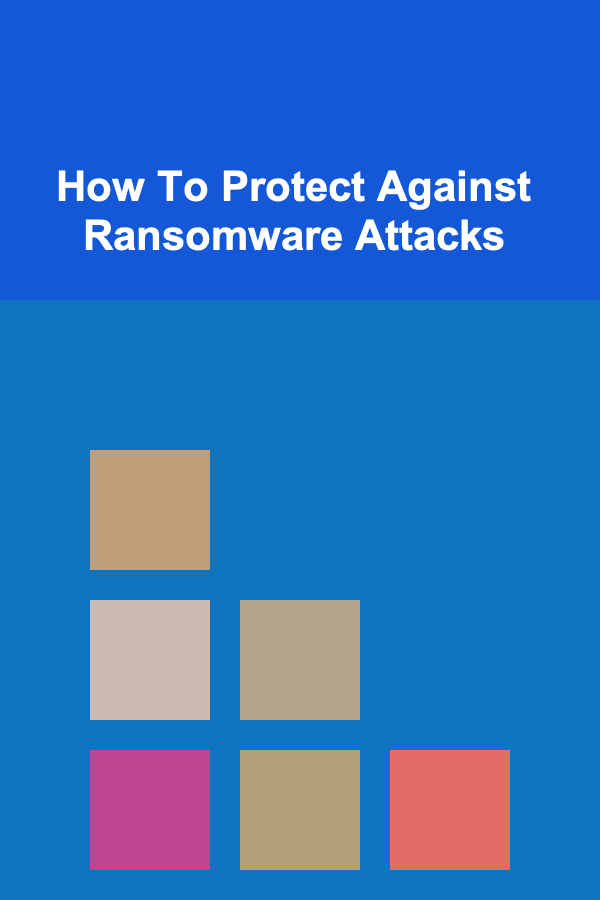
How To Protect Against Ransomware Attacks
ebook include PDF & Audio bundle (Micro Guide)
$12.99$5.99
Limited Time Offer! Order within the next:

Ransomware attacks have become one of the most prominent and dangerous cybersecurity threats in recent years. With high-profile attacks against governments, healthcare systems, and private companies, these malicious attacks have disrupted entire industries and exposed vulnerabilities in digital infrastructures worldwide. As ransomware evolves, it targets various sectors, causing data breaches, financial losses, and even jeopardizing critical services like healthcare.
In this comprehensive guide, we will explore what ransomware is, how it works, the types of ransomware attacks, and most importantly, how you can protect yourself, your organization, or your business against these threats.
What Is Ransomware?
Ransomware is a type of malicious software (malware) designed to block access to a computer system or encrypt files, demanding payment (typically in cryptocurrency) from the victim in exchange for the decryption key or the restoration of access. Once installed on a device or network, ransomware can quickly spread to critical files or systems and effectively lock users out, making files and applications unusable. Ransomware attacks usually come with a ransom note, threatening that the victim's data will either remain inaccessible or be deleted unless payment is made.
Ransomware can target individuals or organizations and can cause severe financial and operational damage. In some cases, cybercriminals may also threaten to release sensitive information if the ransom is not paid.
How Ransomware Works
Ransomware typically spreads via phishing emails, malicious attachments, infected websites, or even through vulnerabilities in outdated software. Once the ransomware is executed, it begins encrypting files on the affected system. The encryption process is often done using strong encryption algorithms, making it nearly impossible to reverse without the decryption key, which is held by the attacker.
The key steps in the operation of a ransomware attack include:
- Infection: Ransomware is typically spread through malicious links or attachments in phishing emails or websites. Once clicked, the ransomware is downloaded and executed on the victim's system.
- File Encryption: Once executed, the ransomware encrypts important files on the system, rendering them inaccessible. In some advanced cases, it may also encrypt system files or backup data, making recovery difficult.
- Ransom Demand: After encrypting the files, the ransomware displays a ransom note, demanding payment in cryptocurrency (often Bitcoin) in exchange for the decryption key.
- Decryption (if ransom is paid): If the victim pays the ransom, the attacker may or may not provide the decryption key. There is no guarantee that paying the ransom will result in the safe return of data.
- Reinfection (in some cases): In some attacks, even after paying the ransom, the victim's systems may be reinfected due to poor security practices or failure to patch the vulnerability that allowed the attack in the first place.
Types of Ransomware
There are several types of ransomware, each with its own characteristics and method of infection. The two most common types are:
1. Crypto Ransomware
Crypto ransomware encrypts the victim's files using a complex encryption algorithm, making them unreadable without a decryption key. The most infamous ransomware variants, such as WannaCry, Petya, and Ryuk, belong to this category. Once encryption is complete, the ransomware demands a ransom payment in cryptocurrency.
2. Locker Ransomware
Unlike crypto ransomware, which encrypts files, locker ransomware locks the victim out of their device or system entirely. Users can still access their files, but the ransomware prevents them from logging into their system or using applications. The ransom demand usually accompanies a message stating that the system will remain locked unless the ransom is paid.
Other ransomware variants include:
- Double Extortion Ransomware: In addition to encrypting files, the attackers exfiltrate sensitive data and threaten to release it unless the ransom is paid. Examples include the Maze and REvil ransomware families.
- Ransomware-as-a-Service (RaaS): RaaS allows cybercriminals without technical expertise to launch ransomware attacks by purchasing access to a pre-configured ransomware tool. This has led to a rise in ransomware attacks, as it lowers the entry barrier for attackers.
Impact of Ransomware Attacks
The impact of ransomware attacks can be devastating for individuals, businesses, and even governments. Some of the most notable consequences include:
- Financial Loss: The ransom payments themselves can be significant, often ranging from thousands to millions of dollars. Additionally, businesses may face operational disruptions and costs related to restoring systems and data.
- Data Loss: While paying the ransom may seem like the quickest way to regain access to encrypted files, there is no guarantee that the attacker will provide the decryption key, leading to permanent data loss.
- Reputation Damage: Ransomware attacks can seriously harm an organization's reputation, especially if sensitive customer data is involved or if the business fails to recover promptly. This can lead to loss of customers, legal consequences, and long-term brand damage.
- Operational Disruption: In some cases, ransomware attacks can disrupt critical operations for extended periods, especially in sectors like healthcare, energy, and finance. For example, hospitals hit by ransomware may be forced to delay or cancel procedures, jeopardizing patient care.
How to Protect Against Ransomware Attacks
While ransomware attacks are highly sophisticated and evolving, there are numerous steps you can take to protect yourself and your organization. Prevention is the best defense, and implementing a multi-layered security strategy is essential for minimizing risks.
1. Regularly Update Software and Systems
One of the most effective ways to prevent ransomware attacks is to ensure that all software, including operating systems and applications, is kept up-to-date. Cybercriminals often exploit vulnerabilities in outdated software to deploy ransomware.
- Enable automatic updates for operating systems and applications.
- Regularly patch and update third-party software, especially those that connect to the internet.
- Prioritize updating critical software components like web browsers, security software, and email clients.
2. Implement Strong Email Filtering and Anti-Phishing Measures
Since phishing is one of the most common entry points for ransomware, implementing strong email security is vital. Employees should be trained to identify phishing attempts, and email systems should be configured to block malicious attachments or links.
- Use email filtering solutions that scan for malicious attachments or links.
- Set up rules that flag or block suspicious emails, especially those from unfamiliar sources.
- Employ multi-factor authentication (MFA) to add an extra layer of security to email accounts.
3. Use Anti-Malware and Antivirus Software
Anti-malware and antivirus software are critical for detecting and blocking ransomware before it can cause harm. Ensure that the software is updated regularly and that it runs real-time scanning.
- Install and update reputable antivirus software on all devices.
- Use behavior-based detection to identify suspicious activity indicative of ransomware.
- Set up automated scans to detect and remove threats before they spread.
4. Backup Your Data Regularly
One of the best ways to mitigate the impact of a ransomware attack is to regularly back up important data. A comprehensive backup strategy ensures that you can restore your systems and data even if they are encrypted or lost during an attack.
- Perform regular backups of critical systems and data to an external device or cloud service.
- Store backups offline or in a separate network to avoid ransomware accessing them.
- Test your backups periodically to ensure that you can successfully restore data.
5. Educate Employees and Users
Employee awareness is one of the most effective defenses against ransomware. Since phishing emails are the most common method of infection, users should be trained to recognize suspicious emails and avoid clicking on unknown links or downloading attachments from untrusted sources.
- Provide ongoing cybersecurity training and awareness programs for employees.
- Use simulated phishing campaigns to test employee responses and improve awareness.
- Encourage employees to report suspicious emails or activities immediately.
6. Implement Network Segmentation and Least Privilege Access
Limiting the spread of ransomware across your network can be achieved by implementing network segmentation and controlling access to critical systems. This way, even if ransomware infects one part of the network, it cannot easily spread to other areas.
- Segment your network to separate critical systems from less important ones.
- Use the principle of least privilege, ensuring that users and applications have access only to the resources they need.
- Enforce strict access controls and monitor network traffic for abnormal behavior.
7. Use Multi-Factor Authentication (MFA)
MFA is a simple yet powerful security measure that adds an extra layer of protection to your systems. By requiring a second form of authentication (such as a code sent to a mobile device), MFA helps prevent unauthorized access, even if an attacker has obtained login credentials.
- Implement MFA on all sensitive accounts, including email, remote access systems, and financial systems.
- Use MFA for administrative accounts to reduce the risk of privilege escalation.
- Require MFA for VPN access to protect your network from unauthorized connections.
8. Develop an Incident Response Plan
Having an incident response plan in place is essential for minimizing the damage caused by a ransomware attack. The plan should outline the steps to take in the event of an attack, including how to contain the infection, restore data from backups, and communicate with affected parties.
- Develop a detailed incident response plan that includes ransomware scenarios.
- Designate a response team with clear roles and responsibilities.
- Regularly test and update your incident response plan to ensure that it remains effective.
9. Consider Cyber Insurance
While prevention is crucial, no defense is 100% foolproof. Cyber insurance can help mitigate financial losses caused by ransomware attacks and other cyber incidents. It is important to understand the terms and conditions of the policy, particularly regarding ransomware-related claims.
- Review and consider investing in a cyber insurance policy that covers ransomware attacks.
- Ensure that the policy covers ransom payments, data recovery, and reputational damage.
- Work with your insurance provider to develop a ransomware response strategy.
Conclusion
Ransomware attacks are one of the most dangerous cybersecurity threats facing individuals and organizations today. However, by adopting a proactive and layered approach to cybersecurity, you can significantly reduce the risk of falling victim to these attacks.
From keeping systems up-to-date to educating employees and implementing robust data backup strategies, there are many steps you can take to defend against ransomware. By staying vigilant, investing in security measures, and developing an effective incident response plan, you can ensure that your systems are well-protected against ransomware and other cyber threats.

How to Create a Content Creation Checklist for Maximum Productivity
Read More
How to Mix and Match Budget Decor with High-End Pieces
Read More
How to Stay Relevant in a Rapidly Changing Remote Job Market
Read More
The Financial Advisor's Toolkit: Essential Skills for Managing Wealth and Growth
Read More
What Are the Best Ways to Organize Your Home Library?
Read More
How to Connect with Nature Through Outdoor Yoga
Read MoreOther Products

How to Create a Content Creation Checklist for Maximum Productivity
Read More
How to Mix and Match Budget Decor with High-End Pieces
Read More
How to Stay Relevant in a Rapidly Changing Remote Job Market
Read More
The Financial Advisor's Toolkit: Essential Skills for Managing Wealth and Growth
Read More
What Are the Best Ways to Organize Your Home Library?
Read More